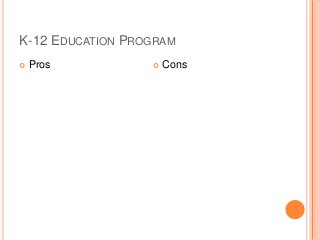
K 12 education program
- 1. K-12 EDUCATION PROGRAM Pros Cons
- 2. PROS The pros which is basically the side of the government, well-heeled and articulate leaders from academe, the business and the media.
- 3. Enhancing the quality of basic education in the Philippines is urgent and critical. The poor quality of basic education is reflected in the low achievement scores of Filipino students. One reason is that students do not get adequate instructional time or time on task. International test results consistently show Filipino students lagging way behind practically everybody else in the world. In the 2008 mathematics exam, for example, we came in the dead last. The congested curriculum partly explains the present state of education. Twelve years of content are crammed into ten years.
- 4. This quality of education is reflected in the inadequate preparation of high school graduates for the world of work or entrepreneurship or higher education. If ten years were adequate, how come employers do not hire fresh high school graduates. Most graduates are too young to enter labour force. Since most children start grade 1 when they are six years old, they do not reach legal employable age of 18 when they graduate high school today. The current system also reinforces the misperception that basic education is just a preparatory step for higher education. Why prioritize the minority of high school graduates that go to college?
- 5. The short duration of the basic education program also puts the millions of overseas Filipino workers (OFWs), especially the professionals, and those who intend to study abroad, at a disadvantage. Our graduates are not automatically recognized as professionals abroad.” The best examples are our engineering graduates, who are condemned to international jobs not befitting their professional status due to our not having a 12-year basic education cycle
- 6. CONS The Cons which are basically the common people whose pockets would adversely impacted by the proposed additional 2 years of basic education.
- 8. Parents have to shell out more money (for transportation and food) for the education of their children. The government does not have the money to pay for two more years of free education, since it does not even have the money to fully support today’s ten years. DepEd must first solve the lack of classrooms, furniture and equipment, qualified teachers, and error-free textbooks. We can do in ten years what everyone else in the world takes 12 years to do. Why do we have to follow what the rest of the world is doing? Filipinos right now are accepted in prestigious graduate schools in the world, even with only ten years of basic education.
- 9. As far as the curriculum is concerned, DepEd should fix the current subjects instead of adding new ones. The problem is the content, not the length, of basic education. We need to have better education, not more education. While students are stuck in Grades 11 and 12, colleges and universities will have no freshmen for two years. This will spell financial disaster for many private Higher Education Institutions (HEIs). K-12 is the Aquino government’s way out to the grave problem of unemployment. To sustain the government’s labor export policy, it needs to create a generation of educated youth who are immediately deployable for labor export.
- 10. Under this system, it seeks to have the Filipino youth graduate and finished high school as 18 years old; it is the age which can legally enter into labour market. Every family dreams of having a child graduate from college. The drop-out rate will increase because of the two extra years. Lastly, by putting into operation the K-12, the Aquino government will further advance its policy of abandoning tertiary education and will rationalize the absolute cut off of state support for colleges and universities.
